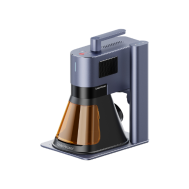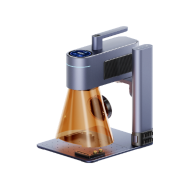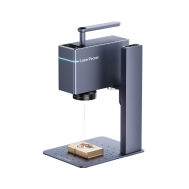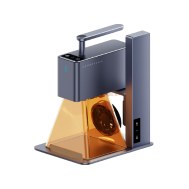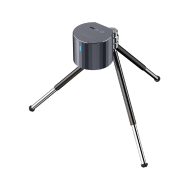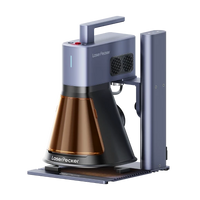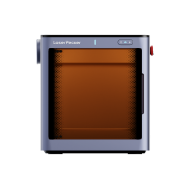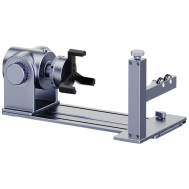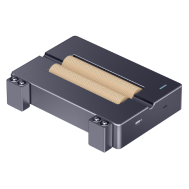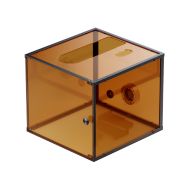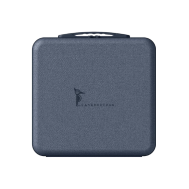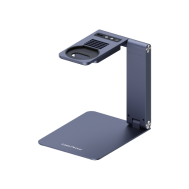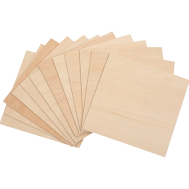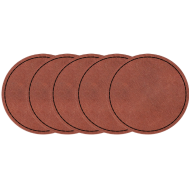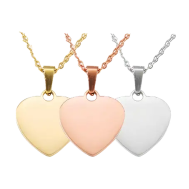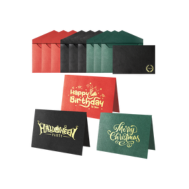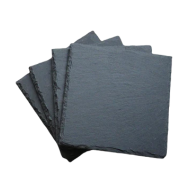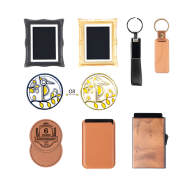Jewelry making is both an art and a craft, allowing you to create personalized accessories that reflect your style. Whether you want to design modern, intricate pieces or simple, classic items, there are multiple techniques to bring your ideas to life.
In this guide, we'll explore 5 popular methods for making jewelry, from high-tech tools like laser machines and cricut makers to hands-on techniques like beading and plier work. Each method offers unique possibilities for materials, designs, and levels of detail, giving you the freedom to experiment and craft your own stunning pieces.

In this article:
- Method 1: Make Jewelry with a Laser Machine
- Method 2: Make Jewelry with a Rotary Tool
- Method 3: Make Jewelry with a Cricut Maker
- Method 4: Make Jewelry via Beading
- Method 5: Make Jewelry via Plier
Method 1: Make Jewelry with a Laser Machine
Using a laser machine for jewelry making allows for precise cutting, engraving, and etching on a variety of materials such as acrylic, wood, leather, and coated metals.
This method is ideal for creating intricate patterns, detailed designs, and custom shapes that are difficult to achieve by hand. Laser cutting ensures clean edges and consistent results, making it perfect for pendants, charms, earrings, and other decorative pieces. It's a fast, accurate, and highly customizable technique suited for both beginners and professional jewelry makers.
Best for:
- Acrylic
- Wood
- Leather
- Certain coated metals
① Make Acrylic Jewelry with a Laser Machine
Acrylic is lightweight, durable, and available in many colors and finishes. Laser cutting allows you to create precise shapes, intricate patterns, and layered designs for earrings, pendants, and charms. Engraving adds texture or personalized details, making each piece unique.

Source: Project from LaserPecker CraftZone
② Make Wood Jewelry with a Laser Machine
Thin wood sheets like balsa or plywood can be cut and engraved to produce natural, rustic jewelry. Laser cutting enables delicate designs and clean edges, while engraving highlights patterns or text. Wood jewelry often has a warm, organic aesthetic.
③ Make Leather Jewelry with a Laser Machine
Laser machines can cut and engrave both natural and faux leather, creating lightweight and flexible pieces like bracelets, earrings, and pendants. The precision of the laser ensures clean cuts without fraying, and engraving adds detailed patterns or monograms.
④ Make Metal Jewelry with a Laser Machine
Laser works well on brass or anodized aluminum, producing durable, modern-looking pendants, tags, and charms. The LP5 Laser Cutter can handle thin metal sheets effectively, while cutting thicker metal typically requires specialized lasers. Even without cutting, engraving enables precise text, logos, and decorative designs on metal surfaces.
Method 2: Make Jewelry with a Rotary Tool
A rotary tool is a compact, high-speed device that can cut, grind, drill, carve, and polish, making it highly versatile for jewelry making. By switching between different attachments, it can handle a variety of materials such as metal, stone and wood. For metal jewelry, it's ideal for shaping, engraving, and polishing pieces like pendants, rings, and charms.
With diamond-coated bits, it can drill and refine stone or gemstone components, while for wood it allows for intricate carving and smooth finishing. Its precision and adaptability make it a valuable tool for both detailed decorative work and essential jewelry-making tasks.
① Make a Metal Jewelry with a Rotary Tool
Examples: Rings, pendants, bracelets, stamped charms
Step 1: Cut and shape - Use a cutting wheel or metal cutting bit to trim the metal to the desired shape.
Step 2: Drill holes - Use a small drill bit to create holes for jump rings or chains.
Step 3: Engrave or texture – Swap to an engraving bit or diamond burr for patterns and details.
Step 4: Polish – Use polishing wheels with compound to give a smooth, shiny finish.
Tips:
- Keep the tool speed moderate to avoid overheating the metal.
- Wear eye protection and gloves.
② Make a Stone Jewelry with a Rotary Tool
Examples: Stone pendants, cabochons, decorative beads
Step 1: Shape the stone – Use a diamond grinding wheel or burr to rough out the shape.
Step 2: Smooth the surface – Switch to finer grit diamond bits to refine edges.
Step 3: Drill holes – Use a diamond-coated drill bit with water as a coolant to avoid cracks.
Step 4: Polish – Use a felt polishing wheel with diamond paste for a glossy surface.
③ Make a Wood Jewelry with a Rotary Tool
Examples: Wooden earrings, carved pendants, inlay work
Step 1: Cut to shape – Use a small saw or cutting bit to create the basic form.
Step 2: Carve details – Use carving or engraving bits for patterns and designs.
Step 3: Sand – Switch to sanding drums to smooth surfaces.
Step 4: Drill holes – Use small drill bits for earring hooks or stringing.
Step 5: Finish – Apply wood oil, varnish, or resin for durability and shine.
Method 3: Make Jewelry with a Cricut Maker
A Cricut Maker is a computer-controlled cutting machine that excels at creating lightweight, intricate jewelry pieces from thin materials. It works best with faux leather, natural leather, cardstock, vinyl, and thin wood sheets like balsa. By using the design software, you can create or import custom patterns, then let the Cricut Maker cut them with precision that's hard to achieve by hand.
This method is ideal for making earrings, pendants, charms, and layered designs, especially when you need multiple identical pieces. While it's limited to relatively thin and soft materials, its speed, repeatability, and ease of use make it a great option for stylish, modern jewelry projects.
① Make Faux Leather Jewelry with a Cricut Maker
Faux leather is lightweight, flexible, and easy to cut, making it perfect for statement earrings, layered pendants, and bracelet cuffs. The Cricut Maker cuts it cleanly without fraying, and you can add texture, patterns, or foil accents for a polished finish.
② Make Cardstock Jewelry with a Cricut Maker
Cardstock is inexpensive, versatile, and available in endless colors and patterns. While it's not as durable as other materials, it's excellent for fashion-forward, lightweight designs like paper earrings, geometric pendants, or costume jewelry. Adding sealants or lamination can improve longevity.
③ Make Wood Jewelry with a Cricut Maker
Using thin wood sheets like balsa or basswood, you can create natural, rustic jewelry pieces such as wooden charms, minimalist pendants, and engraved earrings. The Cricut Maker cuts thin wood precisely, but designs should avoid overly delicate sections to prevent breakage.
④ Make Vinyl Jewelry with a Cricut Maker
Vinyl offers vibrant colors and smooth finishes, perfect for modern, bold designs. You can cut vinyl alone or layer it over other materials like acrylic or leather for more durability. It's especially popular for making decorative charms, name pendants, and personalized statement pieces.
Method 4: Make Jewelry via Beading
Beading is a versatile and beginner-friendly way to make jewelry by stringing beads of various shapes, sizes, and materials onto wire, thread, or elastic cord. This method allows you to create everything from simple bracelets and necklaces to intricate, multi-strand designs.
By mixing colors, textures, and bead types—such as glass, gemstone, wood, or metal—you can produce unique pieces that reflect your personal style. It's an accessible technique that requires minimal tools and offers endless creative possibilities.
Best for:
- Gemstones and semi-precious stones
- Glass beads
- Wood beads
- Plastic/acrylic beads
Method 5: Make Jewelry via Plier
Plier work is a fundamental technique in jewelry making that involves shaping, bending, and connecting wire, chains, and findings to create finished pieces. Using tools like round-nose pliers, chain-nose pliers, and flat-nose pliers, you can make wire-wrapped pendants, attach clasps, form loops, and assemble earrings, bracelets, and necklaces.
This method is versatile, allowing for precise control and customization, and is often combined with other techniques like beading or gemstone setting to complete a piece.
Best for:
- Metals (wire, chain)
- Beads (glass, crystal, plastic, gemstone)
- Jump rings, clasps, and other findings
Conclusion:
Choosing the right jewelry-making method depends on your materials, design complexity, and personal preference. From precision cutting and engraving with a laser cutter to the creative flexibility of beading or wire work with pliers, each technique has its own strengths and charm. By trying different methods, you can discover which works best for your style and projects, and unlock endless opportunities to craft beautiful, custom jewelry.















